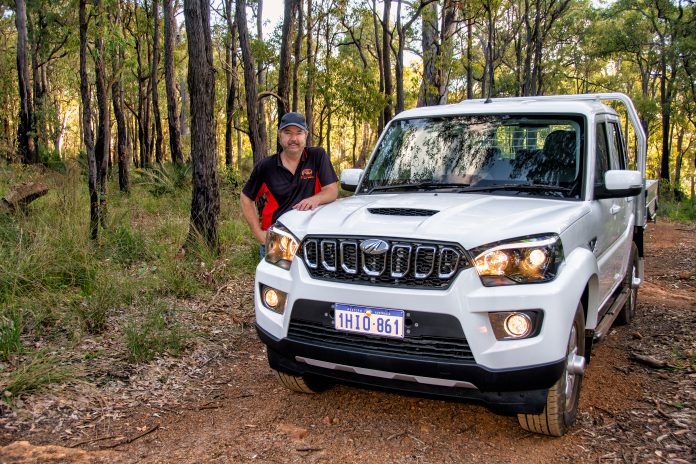To borrow a phrase from early Star Trek days, “It’s a ute Jim, but not as we know it.”
Every so often, there’s a pleasant surprise when a new vehicle surpasses your expectations. It could be something such as the peace of a quiet interior with well suppressed engine noise and unlooked for comfort without excess road vibrations. Or the unexpected tenacity of a diesel engine to deliver real mid-range punch while still being capable of crawling along rutted tracks at ridiculously low rpm without shudder or complaint. Well, I’ve just spent time in a vehicle that delivered not one but all three surprises!
The Mahindra 4×4 S10+ dual cab ute was exactly what Kath and Kim would describe as “Noice, different, unusual.” (And I promise that’s the last reference to old TV shows).
Let’s address the elephant in the room straight up; we all tend to be wary of something unproven. A new brand often meets with a dubious reaction or underlying bias, either because it hasn’t been around long enough on our patch of turf to gain a following or because it doesn’t fit what we have been cozened into accepting as the accepted norm.
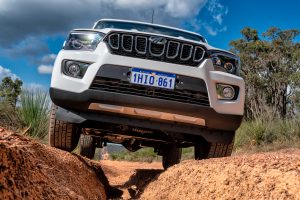
That doesn’t mean you should look to the Mahindra ute for a direct challenge to the Hilux, Ranger, D-Max or Navara, as you’ll be sadly disappointed. At a little over 35K, what this simplistic, unpretentious and basic ute offers is a genuine option for those who don’t need or want the expensive inclusion of all the bells and whistles. It’s aimed at a working environment surrounded by animals or crops where autonomous braking, rear cross traffic alert and adaptive cruise control are superfluous expensive tech that adds no value to driving around a farm. That’s where the Mahindra makes sense, and you can appreciate this ute’s strengths.
Its external aesthetics will not ignite the photographic paparazzi, but in the real world where function takes priority over form, the Mahindra dual cab makes no apologies for its lack of panache. This is no pseudo-SUV; it’s a worker in hard yakka overalls ready to get the job done. Obviously sharing its DNA with the Mahindra Scorpio S11 four door wagon variants; there’s the tell tail rear wheel arch infills just behind the rear door, as they have surgically removed the back end to accommodate the practicality of a rear tub or optional tray back.
The Mahindra’s vertical sides and box like shape provide the tangible benefit of shoulder and headroom in a spacious cabin. Interior design is basic; manually adjustable front seats are comfortable and offer reasonable support with the bonus of arm rests for additional comfort. The driver’s seat gets a height adjustment lever. An upright high seating position feels strange at first, but you quickly become accustomed to it. The low side windows, large flat windshield and proper sized wing mirrors provide excellent visibility. That tiny, snubbed bonnet enhances visual awareness of frontal extremities to make vehicle placement a breeze, both on and off-road.
Simple instrumentation, and basic switch gear is all you need to operate wipers and lights; with the convenience of phone and audio volume controls on the steering wheel, which only has tilt adjustment but no reach functionality. While the 7-inch centre screen isn’t overly large by today’s standards, operation is easy and intuitive. It provides access for blue tooth media streaming, phone and navigation, including a range of vehicle information screens. There’s also a standard reversing camera, but the video was a little too dark and contrasty. Directly below is the AC and heating with large rotary knobs, for easy adjustments if wearing gloves on a frosty morning. The soft blue LED readout for AC temperature and the vertical positioning of the main screen were great in shadow but hard to read in direct sunlight and even worse when wearing sunglasses. It’s a substantial improvement over the previous versions and kudos to Mahindra for the improvements.
Connectivity is via a single USB port on the lower dash for charging your phone, and 12v cigarette power sockets at the front and rear of the console, plus AC vents at the back to help keep rear passengers cool. Storage is at a premium, with no usable console bin, and only small recesses for keys or loose change, plus a slot in front of the gear lever to stop your mobile phone sliding around the cabin floor. The glove box isn’t overly large either and the front door pockets would struggle to hold more than a few pens or a small notebook.
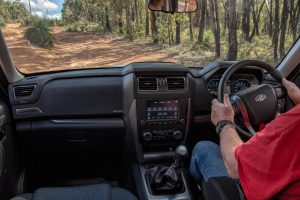
Nope no room for the Nike water bottle, Gucci sunglasses case or the Grande sized mochaccino… but perfect to keep some additional split pins on hand for the tractor, fencing pliers to re-tension the wire strainers, and a couple pairs of leather rigger’s gloves sitting atop of the ratchet straps on the passenger’s front floor for easy access. Then put the all-important cardboard box on the back seat with a flask of hot coffee and a proper ploughman’s lunch. As for the interior finish, it’s hard plastics everywhere. Which is a plus as there will be no guilt when everything gets covered in a fine layer of gravel dust. Blow it out with an air gun; job done – I liked it!
Rear seating is perfectly acceptable, and there are twin ISOFIX points with a top tether. Back passengers get larger door bins capable of holding drink bottles, and what appears to be a hard-shelled pocket on the door skin possibly suitable for a mobile phone, or safekeeping of those spare padlocks for the machine shed. The three head rests across the back are nicely curved to cradle your head. But you’ll want to make sure you push them down to their lowest height when not in use, as they do restrict rear view. Ingress could have been made easier with some grab handles on the A and B pillars, as roof handles can be awkward at times.
Thankfully, someone got the concept of a side rail step. Albeit not a genuine rock slider, it’s considerably more robust than typical lightweight flimsy alloy decorative side boards. The only oddity was the metal bar at floor level on the rear of the front seat frames, leaving you with a rod under your toes, which might be annoying on longer trips.
On the road; smooth, hushed, and easy to drive was the order of the day. The Mahindra’s cabin was impressively quiet, with tyre noise only audible on rougher surfaces and a little wind noise evident over the wing mirrors at highway speeds. Even the torsion bar front suspension and rear longitudinal leaf springs affixed to the ladder chassis are surprisingly supple at soaking up smaller bumps and minor corrugations on gravel.
Behind the wheel, around town, the Mahindra is an easy drive. The Borg Warner six-speed box is like pushing a hot knife through butter and the clutch is as light as it gets. But the standout is the 2.2 litre intercooled turbo diesel; what a gem. With moderate figures on paper of just 103kWs and 320Nm, it’s how this little oiler delivers the goods which make it feel as though it’s punching way above its weight. The gearing and mid-range torque are simply good fun to play with. There’s a satisfying subtle surge of torque to produce a smile and merging into the 100kph freeway zone from the on-ramp is effortless.
Don’t delude yourself into thinking you’ll be anything more than an annoyance to a 10-speed Ford Raptor peeling away from the lights and you’ll be able to appreciate what the Mahindra offers on your own terms and enjoy the positive characteristics of this vehicle’s driveline.
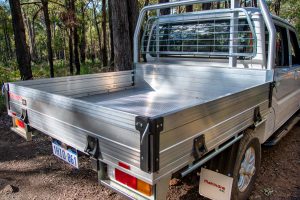 With an indicated drinking habit of 8.8L/100k and an 80L tank onboard, it should see you safely home again with an 850 to 900km range. That will, of course, reduce if you have a full rear tub or tray and haul the Mahindra’s max pay load of 928kgs or pull its full braked towing capacity of 2.5 tonne. Which seems a realistic limitation given the vehicle’s kerb weight is 2,015kg.
With an indicated drinking habit of 8.8L/100k and an 80L tank onboard, it should see you safely home again with an 850 to 900km range. That will, of course, reduce if you have a full rear tub or tray and haul the Mahindra’s max pay load of 928kgs or pull its full braked towing capacity of 2.5 tonne. Which seems a realistic limitation given the vehicle’s kerb weight is 2,015kg.
The hydraulic assisted rack and pinion steering setup feels a little heavy and lethargic around town, and a turning circumference of over 13m makes carpark manoeuvrability challenging. Either practice three point turns or avoid older multi-storey carparks with ludicrously small bays.
With engagement of 4High or 4Low via a large rotary switch on the console, move off-road and that diesel engine excels. Crawling slowly in first gear high range over small washouts, dips and humps with the tacho registering a miserly 800rpm, it felt like the Mahindra was attached to a rail. It’s the closest thing I’ve experienced to the old Land Rover Defender’s anti-stall control. Dab the throttle, and it pulls away without vibration or fuss.
Mostly, the Mahindra easily walked through moderate off-road challenges. With an impressive approach angle of 34 degrees, stepping up small ledges presented no real challenge. Whilst most of the driveline is tucked up out of harm’s way, the modest ground clearance of 210mm and the lack of underbody scuff plates mean you’ll need to focus on wheel placement and larger rocks.
Once the terrain began to stretch the Mahindra’s suspension, the available wheel travel from the rear leaf springs and front torsion bars saw it struggle to maintain forward momentum as opposing wheels began to grab airtime. Fitted with an Eaton mechanical diff lock, the system will engage if the variation in rotational speed between the wheels exceeds 100rpm. It enabled the Mahindra to direct more torque to the wheel still in contact with terra firma and push us through. As a safety mechanism, if the vehicle is traveling over 30kph, the centrifugal force acting upon the counterweight of the Eaton’s lock out mechanism will protect the differential from locking up at high speed.
The factory 16-inch alloys were fitted with General Grabber highway terrain rubber, making for a quieter ride on the blacktop, but some all terrains would further aid in traction and durability for off-road use.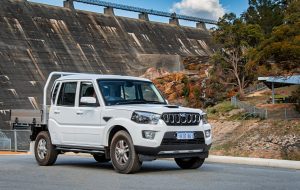 To sum up, this probably won’t suit active families or retirees looking to lap Oz with a large caravan in tow, nor will it be a preferred choice for hard core 4WDrive enthusiasts, especially with a lack of aftermarket accessories.
To sum up, this probably won’t suit active families or retirees looking to lap Oz with a large caravan in tow, nor will it be a preferred choice for hard core 4WDrive enthusiasts, especially with a lack of aftermarket accessories.
But the Mahindra is an excellent choice for those seeking an inexpensive, no frills work ute with 4×4 functionality. It’s ideally suited to the man on the land, a budding tradie starting out or any small business operator without the budget for more expensive alternatives. The Mahindra delivers a modicum of comfort, is easy to drive, has respectable performance and the ability to haul a load, without worrying about dust scratches on piano black finishes or mud on boots. Check out the Mahindra if this suits your buying brief; you too may be pleasantly surprised by the bang you’ll get for your buck.















